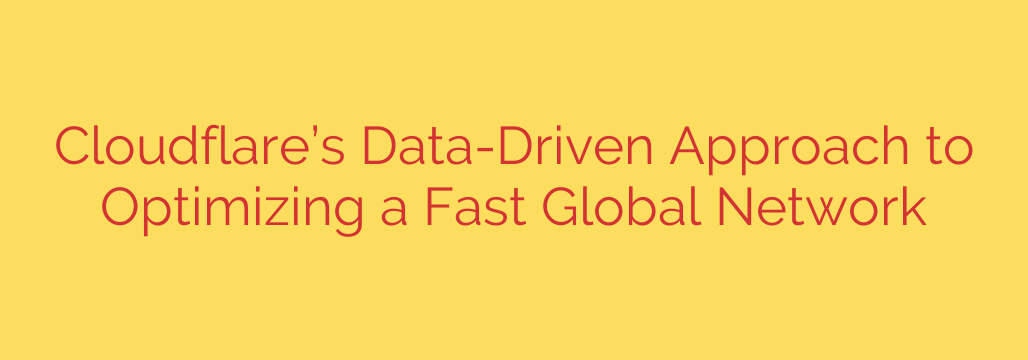
Beyond the Shortest Path: How Data-Driven Routing Builds a Faster Internet
We’ve all experienced it: the frustrating lag in a video call, the slow-loading website, the dropped connection during a critical transaction. While we often blame our local Wi-Fi, the real issue is frequently rooted in the complex, global journey our data takes across the internet. The internet, by its original design, is a “best-effort” system. It prioritizes finding a path for data, not necessarily the fastest or most reliable one.
Traditionally, internet traffic is guided by a protocol called the Border Gateway Protocol (BGP). Think of BGP as the internet’s initial GPS—it finds the shortest route between two points based on the number of network “hops.” However, the shortest path is not always the fastest path. A shorter route might be congested with traffic, like a main street during rush hour, while a slightly longer route, like a clear highway, would get you to your destination much faster.
To overcome these limitations and deliver the speed and reliability modern applications demand, a more intelligent, data-driven approach to network routing is essential.
The Power of a Global View
To make smarter routing decisions, you first need comprehensive data. Imagine trying to navigate a city’s traffic with an outdated map. Now, imagine having a real-time view from thousands of drones, helicopters, and traffic cameras. The difference is night and day.
Similarly, a vast, globally distributed network has a unique vantage point. With data centers in hundreds of cities and connections to thousands of different networks, it’s possible to see the internet not as a static map, but as a living, breathing system with constantly shifting conditions. This global perspective is the foundation for collecting the two types of data needed for true performance optimization.
1. Real-Time Feedback from Real Users
The most accurate measure of network performance is the actual experience of the end-user. This is where Real User Monitoring (RUM) becomes invaluable. By collecting anonymized performance data from billions of real user requests every day, it’s possible to build an incredibly detailed, up-to-the-minute picture of internet health.
This passive monitoring approach measures key metrics like:
- Latency: The time it takes for a data packet to travel from the user to the server and back.
- Packet Loss: The percentage of data packets that get lost in transit, forcing a re-transmission and causing delays.
This data reveals which internet service providers (ISPs) and network paths are currently performing well and which are struggling.
2. Active Probing for a Complete Picture
While RUM data is excellent, it only shows the performance of paths currently in use. To discover potentially faster routes, a network must also perform active network probing. This involves constantly sending small test packets between all data centers in the global network.
These probes measure latency and packet loss across a mesh of thousands of potential paths. This proactive testing ensures that if a primary route suddenly becomes congested or fails, the system already knows the next best alternative without any guesswork.
Turning Data into a Faster Internet
With a constant stream of both real-user and active-probe data, an automated system can make intelligent routing decisions in near-real-time. Here’s how it works:
- Calculate a Performance Score: The system combines latency and packet loss data into a single, unified “performance score” for every possible path. This allows for an objective, apples-to-apples comparison of different routes.
- Identify the Optimal Path: For any given user request, the system analyzes the performance scores of all available paths—whether through direct connections, transit providers, or a private backbone.
- Route Traffic Intelligently: The system automatically steers traffic onto the path with the best current performance score, bypassing congestion and network outages dynamically.
This entire process is like using a navigation app like Waze or Google Maps. It doesn’t just give you the shortest route; it analyzes real-time traffic data to guide you around accidents and traffic jams, ensuring you always take the fastest path available right now.
Actionable Security and Performance Tips for Your Business
While building a global network is out of reach for most, you can leverage these same principles to improve your website or application’s performance and security:
- Utilize a Content Delivery Network (CDN): A modern CDN with a large, distributed network and smart routing capabilities can automatically apply these data-driven principles to your traffic, ensuring users worldwide get the fastest, most reliable experience.
- Implement Load Balancing: Distribute traffic across multiple servers and even multiple cloud providers. This not only improves performance but also enhances resiliency, preventing a single point of failure from taking your service offline.
- Monitor Your Application Performance: Use Application Performance Monitoring (APM) tools to understand your own user experience. This can help you identify bottlenecks in your code, database, or infrastructure that a fast network can’t solve alone.
- Prioritize Network Security: A fast network is only useful if it’s secure. Ensure your provider offers robust DDoS mitigation and a Web Application Firewall (WAF) to protect your infrastructure from malicious attacks that can degrade performance or cause outages.
Ultimately, the future of the internet is not just about building more capacity; it’s about using data to intelligently manage the capacity we have. By moving beyond outdated routing protocols and embracing a dynamic, data-driven approach, we can build a faster, more reliable, and more resilient global network for everyone.
Source: https://blog.cloudflare.com/how-cloudflare-uses-the-worlds-greatest-collection-of-performance-data/








